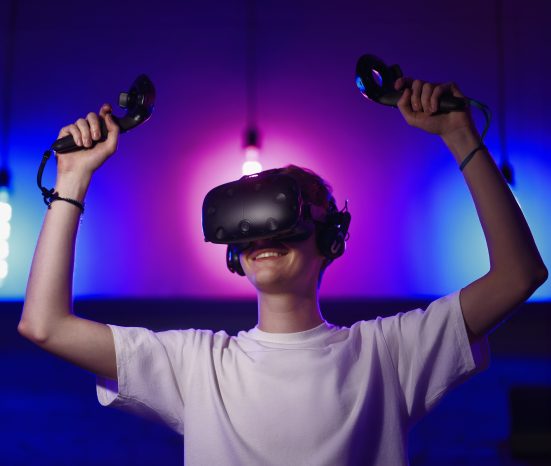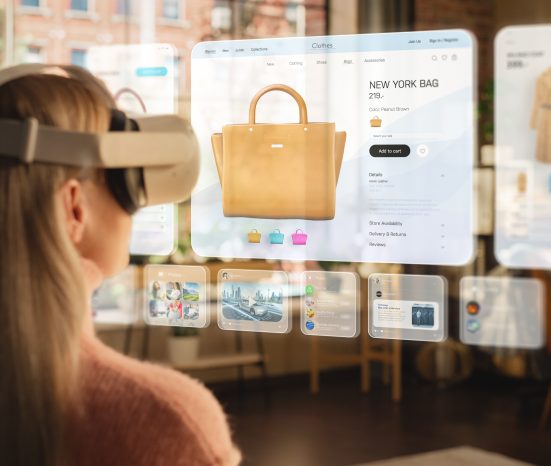The Reality Continuum
What is Virtual Reality (VR)?
The convergence of Artificial Intelligence (AI) and Virtual Reality (VR) technologies has sparked a revolution in the realm of immersive experiences. By combining the computational power and intelligence of AI with the immersive environments of VR, a whole new world of possibilities has emerged. From gaming and education to healthcare and training simulations, the integration of AI and VR is reshaping the way we interact with virtual worlds.
Virtual reality refers to the use of computer modelling and simulation that enables a person to interact with an artificial three-dimensional (3-D) visual or other sensory environments.
Definition of Virtual Reality
VR immerses the user in a computer-generated environment that simulates reality. This is achieved through interactive devices such as goggles, headsets, gloves, or body suits. These devices allow users to experience a simulated world that feels convincing and responsive.
How It Works
- A user typically wears a helmet with a stereoscopic screen, viewing animated images of the simulated environment.
- Motion sensors detect the user’s movements and adjust the view on the screen accordingly, creating the illusion of “being there.”
- Data gloves equipped with force-feedback devices provide tactile sensations, allowing users to pick up and manipulate objects within the virtual environment.
Origins and Development
- The term “virtual reality” was coined in 1987 by Jaron Lanier, a researcher and engineer who contributed to the nascent VR industry.
- Early VR research and technology development in the United States received funding from federal agencies like the Department of Defense, the National Science Foundation, and NASA.
- These efforts established links between academic, military, and commercial work, leading to the evolution of VR technology.
In summary, VR creates an immersive experience by blending computer-generated environments with interactive hardware, allowing users to explore and interact within these virtual worlds.
It differs from augmented reality (AR) as follows:
Definition of Augmented Reality
- VR users are completely immersed in a computer-generated environment. They wear headsets or goggles that block out the real world, replacing it with a simulated one.
- AR overlays digital information onto the real world. Users can still see their surroundings while additional digital content (such as graphics, text, or 3D models) is superimposed onto it.
Environment
- VR: Isolated and fully synthetic environment. Users are “transported” to a different place or scenario.
- AR: Blends digital content with the real world. Users interact with both simultaneously.
Hardware
- VR: Requires specialized headsets or goggles (e.g., Oculus Rift, HTC Vive) that block external visual input.
- AR: Often uses smartphones, tablets, or AR glasses (e.g., Microsoft HoloLens, Google Glass) to overlay digital content onto the user’s view.
Use Cases
- VR: Gaming and entertainment (e.g., immersive video games). Training simulations (e.g., flight simulators, medical training). Virtual tours and experiences.
- AR: Navigation (e.g., GPS directions overlaid on real-world streets). Retail (trying on virtual clothes or visualizing furniture in your home). Industrial maintenance (overlaying repair instructions on machinery).
Interaction
- VR: Users interact with the virtual environment using controllers, gestures, or body movements.
- AR: Users interact with both the real world and digital content. Interaction can involve touchscreens, voice commands, or gestures.
Examples
- VR: Imagine exploring a sunken shipwreck on the ocean floor without leaving your living room.
- AR: Picture using your phone to find nearby restaurants, with their names and ratings displayed over the real-world view.
In summary, VR immerses users in a fully synthetic environment, while AR enhances the real world by overlaying digital elements.
Mixed Reality (MR) is a blend of VR and AR
Definition: MR combines elements of VR and AR, creating a seamless continuum between the real world and digital content.
Continuum: Imagine a spectrum with VR on one end (complete immersion) and AR on the other (partial immersion). MR sits in the middle, allowing users to interact with both real-world objects and virtual elements simultaneously.
Physical and Digital Integration: In MR, digital objects are anchored to physical space. They interact with real-world surfaces, objects, and lighting. Users can see and manipulate virtual content as if it exists alongside their physical surroundings.
Hardware: MR devices include headsets or glasses that blend real-world views with digital overlays. Examples: Microsoft HoloLens, Magic Leap, and some smartphone apps.
Use Cases
- Design and Visualization: Architects can overlay 3D models onto construction sites.
- Education: Interactive learning experiences, such as dissecting a virtual frog on your desk.
- Collaboration: Remote teams can share and manipulate 3D models in a shared MR space.
- Gaming: Combining real-world environments with virtual game elements.
Example Scenario
Imagine you’re fixing a broken pipe under your sink. With MR glasses, you see a step-by-step repair guide overlaid on the actual pipes. As you turn the wrench, the instructions update in real time, showing you the next steps.
In summary, MR bridges the gap between VR and AR, offering a dynamic blend of real-world context and digital enhancements.
Virtual Reality, Augmented Reality, and Mixed Reality in the Aerospace Industry
Here are some examples:
AR for Aircraft Maintenance
AR systems can provide job task training and guidance for novice technicians in a real-world environment. They reduce training costs by complementing human information processing and assisting with job tasks. AR eliminates the need to leave the aircraft for information retrieval from maintenance manuals during inspections and repairs.
VR for Airport Security and Safety Training
VR allows trainees to practice emergency procedures in a virtual facsimile of an airport. It simulates real-world challenges, preparing personnel for disaster response scenarios.
AR for Aircraft Windshields
AR enhances pilots’ ability to visualize terrain, navigation, traffic, weather, and airspace. Information overlays, such as emergency checklists, appear seamlessly without distracting pilots from their primary view.
VR In-Flight Training Simulators
VR-based flight simulators offer cost-effective training for both military and civilian pilots. Pilots can develop skills in handling aircraft under unusual operating conditions and explore new aircraft characteristics.
VR in Space Systems Infrastructure and Operations
VR technology accelerates the development of space systems infrastructure while reducing costs. Applications range from control centre design analyses to extravehicular activity (EVA) operations training for crew and ground controllers.
AR/VR for Design and Manufacturing
Streamlining processes, such as setting wires, saves time and resources.
AR/VR on the International Space Station
VR control of robots and haptic interfaces for remote operation of robotic arms and vehicles.
In summary, these technologies enhance safety, training, and operational efficiency in aerospace.
Combining Artificial Intelligence (AI) with Virtual Reality (VR)
Finally, concluding where we began, the integration of AI with VR holds immense potential and can lead to exciting advancements. For example:
Enhancing Realism: AI-Driven Rendering and Interaction
NeRF (Neural Radiance Fields) is a technology that captures and represents complex 3D scenes or objects by learning their appearance and geometry from images or video footage. It uses deep learning techniques and neural networks to construct a volumetric representation, allowing for more realistic rendering and interaction in VR.
While NeRF is still in its early stages and cannot currently produce fully usable 3D assets for VR, it serves as a valuable tool in the production process. It enables accurate capture of real-world environments, providing a reference for creating 3D models.
Immersive Voice Experiences: AI-Generated Voices in VR
AI-generated voices are prevalent in various applications, including VR. These voices simulate human-like speech patterns and intonations, enhancing the immersive experience for users. Currently, the scripts for these AI-generated voices need to be written by humans, but advancements may lead to fully AI-generated voice content in the future.
Real-Time Data Integration: AI’s Impact on Dynamic VR Experiences
AI algorithms can analyze real-time data from various sources (such as sensors or user inputs) to dynamically adapt VR experiences. This real-time integration allows for personalized and responsive virtual worlds, making VR more engaging and interactive.
Content Creation: Streamlining Development for VR
Generative AI models can create realistic 3D assets, environments, and characters, reducing manual content creation efforts. By leveraging AI, developers can speed up the process of building immersive VR content.
In summary, AI and VR should not be seen as competing technologies; rather, they can work together synergistically to enhance the overall digital experience.
Evolution of Virtual Reality & Augmented Reality

The evolution of Virtual Reality (VR) and Augmented Reality (AR) has transitioned from science fiction concepts to transformative technologies with diverse applications. Early VR efforts in the 1960s and 70s involved rudimentary headsets and motion tracking systems, while AR began gaining traction in the late 1990s with the advent of mobile computing. Advances in computing power, graphics processing, and sensor technology have significantly enhanced the realism and interactivity of VR and AR experiences. Today, VR and AR are utilized in fields ranging from gaming and entertainment to education, healthcare, and industrial training. As technology continues to progress, VR and AR are poised to become integral parts of everyday life, offering immersive and interactive experiences that bridge the digital and physical worlds.
Aerospace & AR/VR in Future
The future of aerospace will be significantly shaped by advancements in AR and VR technologies, enhancing both operational efficiency and training capabilities. Pilots and maintenance crews will benefit from AR-assisted interfaces, providing real-time data and diagnostics directly in their field of view, thus improving accuracy and safety. VR will revolutionize aerospace training programs, offering immersive simulations for pilots and engineers to practice scenarios in a risk-free environment. As these technologies evolve, they will enable more effective design processes, streamlined maintenance procedures, and enhanced situational awareness in aerospace operations.

Frequently Asked Questions
Common questions and answers pertaining to AR/VR, especially in regards to aviation.
How can AR/VR be utilized in pilot training?
AR/VR can create immersive flight simulators that replicate real-world scenarios, allowing pilots to practice and refine their skills in a safe and controlled environment without the risk and cost associated with traditional flight training.
What are the benefits of using AR for aircraft maintenance?
AR can provide maintenance technicians with real-time, hands-free access to repair manuals, diagnostics, and guidance overlays, improving efficiency, reducing errors, and enhancing the accuracy of maintenance procedures.
Can AR/VR improve passenger experience in aviation?
Yes, AR/VR can enhance the passenger experience by offering immersive in-flight entertainment, virtual tours of destinations, and augmented reality wayfinding in airports, making travel more enjoyable and engaging.
What are the challenges of integrating AR/VR into aviation?
Challenges include the high initial cost of implementing AR/VR systems, the need for extensive training to use these technologies effectively, and ensuring the reliability and accuracy of AR/VR applications in critical operations.
How might AR/VR influence the design and manufacturing of aircraft?
AR/VR can streamline the design and manufacturing processes by enabling virtual prototyping, allowing engineers to visualize and test designs in 3D, identify potential issues early, and collaborate more effectively, leading to improved innovation and reduced development times.
Video Explanation
The video below will provide more information as to how this technology works
Example Industry User

VRPilot specializes in utilizing virtual reality (VR) to create immersive training solutions for the aviation industry. By developing realistic VR simulations, VRPilot allows pilots and aviation professionals to practice and refine their skills in a controlled, safe environment. These VR training modules enhance situational awareness, decision-making, and overall proficiency without the risks associated with real-life training scenarios.
Further Resources
Below are some external links to further information on this technology.






